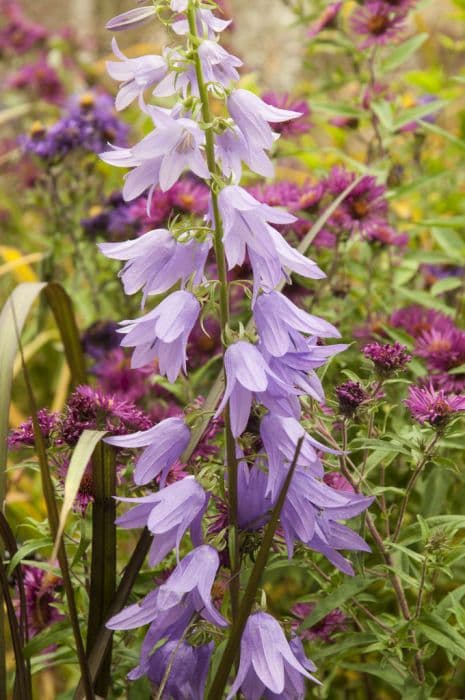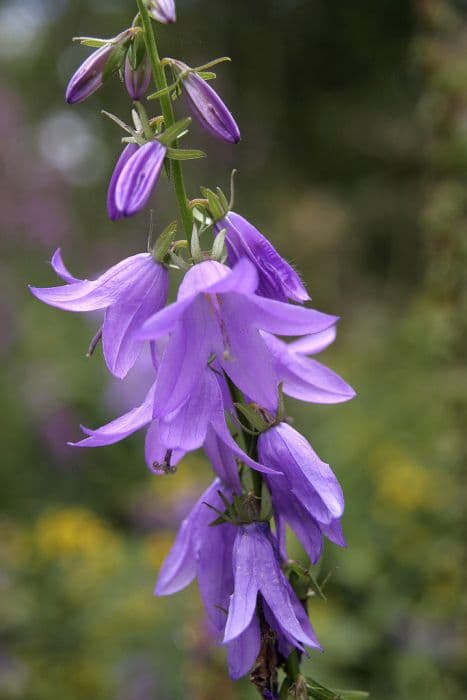Adriatic bellflower Campanula garganica 'Dickson's Gold'

ABOUT
The Campanula garganica 'Dickson's Gold', commonly known as the Adriatic Bellflower, is a striking perennial plant known for its ornamental foliage and charming flowers. The distinct characteristic of this variety is its bright golden-yellow leaves, which provide a vivid backdrop for the star-shaped, blue-purple flowers that bloom profusely. This vivid foliage color is especially eye-catching when the plant is positioned in partial shade, where the golden tones can truly stand out. The flowers are borne on short stems that rise just above the foliage, creating a delightful contrast with the yellow leaves. Each petite flower possesses a bell-like shape that is typical of the bellflower family, and they are attractive to pollinators like bees and butterflies. The vibrant blue-purple of the flowers provides a classic complementary color contrast with the warm golden tones of the leaves, creating a visual interest that can enliven any garden space. As a low-growing and mat-forming plant, the Adriatic Bellflower creates a carpet of color that works well as ground cover or in rock gardens, borders, and containers. The bright foliage keeps the plant interesting even when it is not in bloom, providing gardeners with long-lasting appeal throughout the growing season. Overall, the Adriatic Bellflower is admired for its beautiful combination of golden leaves and blue-purple flowers, making it a standout in the garden for its color and form.
About this plant
 Names
NamesFamily
Campanulaceae
Synonyms
Adriatic Bellflower, Dickson's Gold Bellflower, Gargano Bellflower
Common names
Campanula garganica 'Dickson's Gold'.
 Toxicity
ToxicityTo humans
The Adrian's bellflower is not known to be toxic to humans. Generally, they are considered safe and do not contain any compounds that are harmful if ingested. However, it is always advisable to not consume any plant material unless it is known to be edible and safe.
To pets
The Adrian's bellflower is not known to be toxic to pets. It is generally considered non-toxic to cats and dogs. If a pet were to ingest part of this plant, it is unlikely to cause any serious symptoms of poisoning. However, as with any non-food plant, consumption in large quantities might result in mild gastrointestinal discomfort or upset.
 Characteristics
CharacteristicsLife cycle
Perennials
Foliage type
Deciduous
Color of leaves
Green
Flower color
Blue
Height
0.5 feet (15 cm)
Spread
1 feet (30 cm)
Plant type
Herb
Hardiness zones
7
Native area
Europe
Benefits
 General Benefits
General Benefits- Ornamental Appeal: The plant's bright blue flowers and golden foliage add vibrant color to garden spaces, enhancing aesthetic value.
- Low Maintenance: Requires minimal care once established, making it a good choice for gardeners of all skill levels.
- Drought Tolerance: Adapts to periods of low water availability, reducing the need for frequent watering.
- Attracts Pollinators: Flowers provide nectar and attract bees and other beneficial insects that pollinate other plants in the garden.
- Ground Cover: Spreading habit helps to cover bare ground, suppress weeds, and stabilize soil with its root system.
- Rock Gardens: Well-suited for rock gardens or alpine settings due to its size and ability to thrive in well-drained soils.
- Container Gardening: Its compact size makes it suitable for containers, adding versatility in garden design and placement.
 Medical Properties
Medical PropertiesThis plant is not used for medical purposes.
 Air-purifying Qualities
Air-purifying QualitiesThis plant is not specifically known for air purifying qualities.
 Other Uses
Other Uses- Adriatic bellflower can serve as a model organism in botanical studies due to its distinctive growth habits and readily observable phenological stages.
- It can be used in art and photography for its interesting foliage and flowers, captivating enthusiasts who value the aesthetics of garden plants.
- The bright leaves and blue flowers make an excellent subject for botanical illustration, teaching artists about plant structure and color blending.
- Its creeping nature allows it to be used in creating living mulch that can suppress weeds and retain soil moisture in garden beds or under taller plants.
- Adriatic bellflower can be used in educational settings for studying pollinator interactions, as it attracts a variety of bees and butterflies.
- This plant can be utilized in sensory gardens because of its textural foliage and vibrant flowers which offer visual and tactile stimuli.
- It can be used in container gardening, hanging baskets, or as a spillover plant to add a splash of color and texture to vertical spaces.
- Due to its compact growth, the Adriatic bellflower can be employed in miniature or fairy gardens to create a whimsical landscape effect.
- In areas with suitable climates, it can serve as ground cover in rock and alpine gardens, adding robustness and seasonal interest.
- Adriatic bellflower can be used in cut flower arrangements as a filler, providing a delicate touch of green and soft blue to floral displays.
Interesting Facts
 Feng Shui
Feng ShuiThe Adriatic bellflower is not used in Feng Shui practice.
 Zodiac Sign Compitability
Zodiac Sign CompitabilityThe Adriatic bellflower is not used in astrology practice.
 Plant Symbolism
Plant Symbolism- Constancy: The Campanula genus, commonly known as bellflower, often symbolizes unwavering love and constancy, reflecting the enduring and bell-shaped flowers that stay vivid and persistent throughout their blooming period.
- Gratitude: Bellflowers are also associated with the feeling of gratitude, making them a thoughtful gift when you want to show appreciation to someone special in your life.
- Hope: The bell-shaped blossoms of the bellflower can signify hope; with their heads turned towards the sky, they suggest looking forward optimistically.
- Humility: In some cultures, the delicate appearance of the bellflower is equated with humility, gently reminding us to stay modest and grounded.
- Attractiveness: With their bright colors and gold foliage, such as in 'Dickson's Gold', they can also represent attractiveness and the beauty of nature.
 Water
WaterThe Adriatic bellflower should be watered deeply enough to saturate the root zone, approximately once a week during active growing seasons of spring and summer. In the absence of rainfall, you can provide about one gallon of water per square foot every seven days. During the cooler months of fall and winter, reduce the watering frequency to every other week, or whenever the top inch of the soil feels dry, since the plant’s water requirements decrease as growth slows down. Overwatering can lead to root rot, so ensure the plant is in well-draining soil and the excess water can escape. Always check the soil moisture before watering to avoid soggy conditions.
 Light
LightAdriatic bellflower thrives in full to partial sunlight. The ideal spot for this plant is where it can receive at least four to six hours of sunlight daily. It can tolerate some shade, but too much shade may impair flowering and weaken the plant. A location with morning sun and afternoon shade can help protect the plant from the harsh midday sun during very hot days.
 Temperature
TemperatureAdriatic bellflower does well in a range of temperature conditions, tolerating a minimum of about 20 degrees Fahrenheit, but it prefers cooler conditions and can start to suffer if temperatures rise above 80 degrees Fahrenheit. The ideal temperature range for this plant is between 60 and 70 degrees Fahrenheit. Extreme heat can be detrimental, so providing some shade during the hottest part of the day can help manage temperatures.
 Pruning
PruningPruning the Adriatic bellflower helps to maintain its shape, encourage bushier growth, and improve airflow, which can deter fungal diseases. Prune in early spring before new growth starts, cutting back any dead or damaged stems. After the bellflower has finished blooming, deadheading spent flowers will encourage a second flush of blooms. Annual or biennial pruning is generally sufficient to keep the plant healthy and aesthetically pleasing.
 Cleaning
CleaningAs needed
 Soil
SoilAdrian's Bellflower thrives in a soil mix comprising equal parts of loam, peat, and sharp sand, promoting good drainage and aeration. The ideal soil pH for Adrian's Bellflower should be slightly alkaline, around pH 7.0 to 7.5.
 Repotting
RepottingAdrian's Bellflower typically does not need frequent repotting, and can often go 2-3 years before needing to be moved into a larger pot due to its moderate growth rate.
 Humidity & Misting
Humidity & MistingAdrian's Bellflower prefers moderate humidity levels but can tolerate a range of humidity conditions as long as proper soil moisture is maintained.
 Suitable locations
Suitable locationsIndoor
Use well-draining soil, bright indirect light, and water when topsoil dries.
Outdoor
Plant in well-drained soil, full sun to part shade, and water regularly.
Hardiness zone
3-9 USDA
 Life cycle
Life cycleThe life cycle of Campanula garganica 'Dickson's Gold', commonly known as Adriatic Bellflower, starts from seeds which germinate in spring when soil temperatures rise and moisture is adequate. Seedlings develop into a rosette of heart-shaped, golden-yellow leaves and as they mature, the plants form a low, mounding habit. During late spring to early summer, the plant enters its flowering stage, producing blue, bell-shaped flowers atop short stalks that rise above the foliage. After pollination, typically by bees and other insects attracted by the flowers, seeds develop and are dispersed near the parent plant. In the fall, as temperatures decrease, the Adriatic Bellflower enters a period of dormancy, its growth slows, and above-ground parts may die back, while the root system remains alive. With the return of warmer weather in the following spring, new growth emerges from the root system, and the life cycle repeats.
 Propogation
PropogationPropogation time
Spring-Early Summer
Propogation: Campanula garganica 'Dickson's Gold', commonly known as Dickson's Gold Bellflower, can be propagated effectively through division, which is the most popular method. The ideal time to divide this plant is in the spring, shortly after new growth begins. During division, clumps of the plant should be carefully lifted from the ground and gently teased apart into smaller clumps, ensuring each new section has a portion of the roots attached. These new clumps can then be replanted at the same depth they were growing originally, spaced approximately 12 inches (about 30 centimeters) apart to allow enough room for growth. Watering the newly planted divisions thoroughly helps to establish them in their new location. Regular watering, especially during dry periods, will encourage strong root development and aid in the successful propagation of Dickson's Gold Bellflower.








